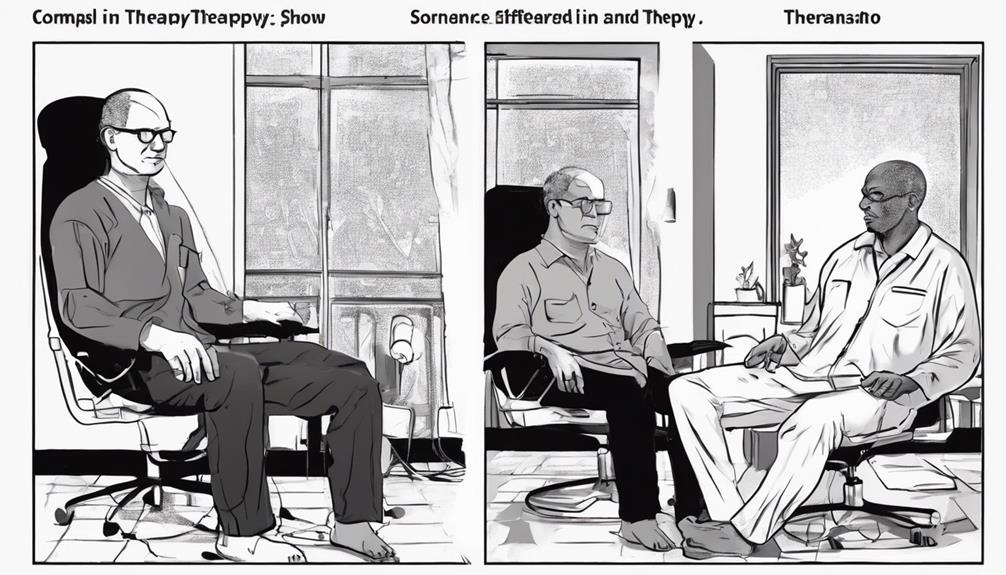Explore the power of somatic therapy in nurturing both your mental and physical health. This method addresses psychological distress through the manifestation of physical symptoms, offering a holistic approach to dealing with trauma. With its emphasis on the interconnectedness of body and mind, it boosts emotional regulation and fosters overall well-being. Clinical trials and personal stories confirm its effectiveness, especially in alleviating symptoms of PTSD and chronic pain. Somatic therapy encourages greater self-awareness, fortitude, and quality of life, paving the way for tailored care and significant improvements in mental health. Delve into the significant advantages of somatic therapy and its scientific foundations to gain a comprehensive insight into its capabilities.
Key Takeaways
- Somatic therapy is backed by scientific evidence.
- Targets neurological basis of somatics for emotional regulation.
- Reduces PTSD symptoms and chronic pain.
- Enhances self-regulation and emotional well-being.
- Offers personalized care for long-term mental health.
Somatic Therapy Fundamentals
Exploring the fundamentals of somatic therapy reveals its focus on the mind-body connection to address psychological distress through physical manifestations. Somatic therapy centers on the belief that the body holds trauma and unresolved emotions that impact one's mental well-being. This therapeutic approach emphasizes the importance of understanding how physical sensations are linked to emotional experiences, promoting self-awareness and healing.
By recognizing the intricate interplay between the body and mind, somatic therapy offers a unique perspective on addressing psychological issues. Through body-centered mindfulness, breathwork, and gentle movement, individuals can begin to release tension, process emotions, and cultivate a deeper connection to themselves.
This approach not only helps in alleviating physical symptoms but also aids in uncovering and working through past traumas stored in the body.
Therapeutic Techniques and Approaches

You'll explore techniques that bridge the gap between your mind and body, like breathwork and movement therapy. These methods are designed to help you release tension, process emotions, and cultivate self-awareness through gentle movement and body-centered mindfulness.
Techniques for Mind-Body Connection
Techniques for fostering a strong mind-body connection in somatic therapy encompass breathwork, movement therapy, and body-centered mindfulness practices. These techniques are designed to help you release tension, process emotions, and cultivate present-moment awareness.
Here's how they work:
- Breathwork: By focusing on your breath, you can regulate your nervous system, calm your mind, and deepen your connection to your body's sensations.
- Movement Therapy: Engaging in gentle movements can help release physical tension stored in the body, allowing for the expression and processing of emotional experiences.
- Body-Centered Mindfulness: This approach encourages you to pay attention to bodily sensations, emotions, and thoughts in a non-judgmental way, promoting self-awareness and acceptance.
- Enhanced Self-Awareness: Through somatic therapy techniques, individuals can become more in tune with their bodies, leading to a greater understanding of how emotions manifest physically and mentally.
Approaches to Release Tension
Somatic therapy employs various therapeutic techniques and approaches to effectively release tension stored in the body. By integrating physical and emotional aspects, somatic experiencing and body awareness help individuals address distress and promote self-awareness.
Techniques like breathwork and gentle movement therapy are utilized to release tension and reconnect with the body. Through body-centered mindfulness practices, individuals can cultivate a deeper understanding of their physical sensations and emotional reactions. The focus on the present moment allows individuals to process emotions and release physical manifestations of distress.
Mindfulness in Healing
Enhancing healing through mindful practices is a key aspect of somatic therapy's therapeutic techniques and approaches. When engaging in mindfulness within the context of somatic therapy, individuals can benefit from various techniques that promote self-awareness and emotional well-being:
- Mindfulness: Cultivating present-moment awareness allows individuals to connect with their bodies and emotions in real-time.
- Self-compassion: By fostering a kind and understanding attitude towards oneself, individuals can navigate challenges with greater ease.
- Breathwork: Utilizing breathwork techniques helps in reducing stress, calming the nervous system, and enhancing emotional regulation.
- Body awareness: Practicing body awareness exercises enables individuals to identify and release tension stored in the body, promoting overall relaxation and healing.
Scientific Underpinnings of Somatic Therapy

You'll explore the neurological basis of somatics, understanding how the body and mind are interconnected.
Research findings on the body-mind connection will shed light on the impact of somatic therapy on emotional regulation.
These points will showcase the scientific foundations supporting the effectiveness of somatic therapy in healing trauma.
Neurological Basis of Somatics
Understanding the neurological basis of somatics is essential for comprehending the scientific foundations of somatic therapy. When delving into the neurological underpinnings of somatics, several key points come to light:
- The brain structure and function are deeply intertwined with the somatic nervous system, influencing how bodily sensations are processed and integrated with emotions.
- Somatic therapy targets bodily sensations to address unresolved trauma, leading to changes in brain structure and function that promote healing.
- Traumatic experiences can leave lasting imprints on the brain, affecting both cognitive and emotional processing, which somatic therapy aims to address.
- By acknowledging the intricate connection between the mind and body, somatic therapy offers a holistic approach to healing psychological distress, rooted in scientific evidence supporting the impact of trauma on the brain and nervous system.
This understanding forms the basis for the effectiveness of somatic therapy in addressing psychological issues through a neurologically informed lens.
Body-Mind Connection Research
Grounded in extensive research on the body-mind connection, somatic therapy emphasizes the significant impact of physical sensations on emotional well-being. Studies highlight that somatic therapy interventions not only influence emotional well-being but also impact brain structure and function. This illustrates the neurobiological basis of healing through body-centered approaches.
By addressing imprints of traumatic experiences in the body, somatic therapy plays a vital role in processing and releasing emotional distress. The involvement of the somatic nervous system in therapy practices supports the effectiveness of somatic approaches in enhancing self-awareness and promoting emotional regulation.
Scientific findings underscore the holistic understanding of the mind-body connection in somatic therapy, showcasing its potential to revolutionize mental health care through integrated approaches. Through ongoing research efforts, the field of somatic therapy continues to evolve, providing further insights into the interconnectedness of physical and emotional well-being.
Impact on Emotional Regulation
Research on the impact of somatic therapy on emotional regulation demonstrates its effectiveness in helping individuals address unresolved emotions through bodily interventions. Somatic therapy plays an essential role in enhancing emotional self-regulation by leveraging the mind-body connection.
Here's how somatic therapy influences emotional regulation:
- Processing Traumatic Experiences: Somatic techniques aid in processing emotions linked to past traumatic experiences, allowing individuals to work through and release these emotions effectively.
- Enhancing Emotional Awareness: Through body-oriented trauma therapy, individuals can develop a deeper awareness of their emotional states and learn to recognize and manage them more skillfully.
- Improving Emotional Resilience: By engaging the body in therapy, individuals can build emotional resilience and cope better with stressors, contributing to overall mental health.
- Facilitating Healing: Somatic therapy helps individuals heal from emotional wounds by addressing the physiological manifestations of unresolved emotions, promoting holistic well-being.
Clinical Evidence and Testimonials

Numerous clinical trials and patient testimonials consistently demonstrate the positive impact of somatic therapy on conditions like PTSD and pain management. Clinical evidence reveals that somatic therapy effectively reduces symptoms of PTSD and chronic pain, improving patients' emotional well-being and overall quality of life.
Testimonials from individuals undergoing somatic therapy highlight benefits such as enhanced self-regulation, reduced anxiety, and improved resilience. Practitioners also observe an increase in self-awareness and the development of resilience in their clients.
The combination of research findings and patient testimonials provides a thorough understanding of somatic therapy's effectiveness in addressing not only physical but also emotional challenges. This evidence underscores the significance of somatic therapy as a valuable approach for promoting holistic well-being and fostering emotional regulation in individuals struggling with trauma, pain, and various other mental health concerns.
Future Potential of Somatic Therapy

The potential for somatic therapy to revolutionize mental health care through innovative technological integration is a prominent focus in discussions about its future impact. As we look ahead, consider these key points:
- Individualized Treatment: Somatic therapy shows promise in tailoring interventions to meet the unique needs of each individual, paving the way for more personalized and effective treatment plans.
- Transformative Impact: With its ability to address both the physical and emotional aspects of well-being, somatic therapy has the potential to profoundly reshape the mental health landscape, offering holistic healing opportunities.
- Technology Integration: The exploration of advanced technologies like virtual reality and neuroimaging enhances the therapeutic possibilities within somatic therapy, opening doors to innovative approaches and enhanced outcomes.
- Enhanced Overall Well-being: By focusing on evidence-based approaches and promoting resilience, somatic therapy is poised to play an essential role in enhancing overall well-being and fostering long-term mental health.
Somatic therapy's future potential lies in its ability to combine personalized care, innovative technology, and holistic approaches to promote resilience and well-being.
Somatic Experiencing (SE) Therapy Overview

Somatic Experiencing (SE) Therapy, developed by Peter Levine for trauma and PTSD, is a body-centered therapy that focuses on physical sensations to address trauma as a physical experience. In SE, touch plays an essential role, with trained practitioners utilizing grounding exercises and educating clients on sensations to navigate trauma-related stress responses. The therapy operates on the principle of foundational processing, aiming to modify the body's response to trauma.
To understand the essence of Somatic Experiencing more vividly, let's explore the core components of this trauma therapy:
| Key Aspects of Somatic Experiencing | ||
|---|---|---|
| Body-centered therapy | Touch | Trauma-related stress responses |
| Foundational processing | Physical sensations | Trained practitioners |
Effectiveness of Somatic Experiencing

Shifting focus to the impact of Somatic Experiencing, consider its effectiveness in reducing PTSD symptoms and addressing trauma through somatic interventions. Studies using randomized controlled trials have shown a significant reduction in PTSD symptoms following Somatic Experiencing sessions.
This trauma therapy: A scoping review of SE's efficacy revealed improvements in self-regulation, decreased chronic stress, and alleviation of physical symptoms associated with trauma. The therapeutic process of SE targets the underlying psychophysiological consequences of trauma, emphasizing the importance of modifying interoceptive and proprioceptive sensations.
SE's method-specific key factors, such as resource-orientation and the use of touch in therapy sessions, contribute to its effectiveness in promoting resilience and self-regulation in individuals exposed to traumatic events. The Science Behind Somatic Experiencing supports its promising role as a bottom-up intervention in PTSD treatment, focusing on enhancing individuals' abilities to manage stress and navigate trauma-related experiences effectively.
Comparative Analysis With Other Therapies

When comparing somatic therapy approaches with other therapeutic techniques, consider the unique emphasis on physical sensations in addressing trauma. Somatic therapy, such as Somatic Experiencing (SE), takes a bottom-up approach, focusing on the body's physiological responses to trauma rather than cognitive processes. This differs from top-down therapies like cognitive behavioral therapy (CBT) and Eye Movement Desensitization and Reprocessing (EMDR), which target thoughts and emotions.
While SE shows promise in reducing PTSD symptoms, scientific research on its effectiveness isn't as conclusive as more established therapies like CBT and EMDR. Somatic therapists utilize touch and grounding exercises to address trauma at a somatic level, emphasizing sensory stimuli to facilitate healing. However, evidence suggests that SE's emphasis on physical sensations may limit its widespread adoption compared to the more widely recognized therapeutic approaches.
In comparative analysis, it's crucial to recognize the strengths and limitations of somatic therapy alongside other modalities, considering the varying emphases on physical sensations, thoughts, and emotions in treating trauma.
Frequently Asked Questions
Is Somatic Therapy Scientifically Proven?
Somatic therapy is scientifically proven to be effective, with research supporting its benefits in reducing PTSD, anxiety, and chronic pain. Positive outcomes in emotional regulation and brain function demonstrate its potential in transforming mental health care.
What Is the Theory Behind Somatic Therapy?
To understand the theory behind somatic therapy, explore how it explores the mind-body connection. Recognize the impact of trauma on your brain and nervous system. By releasing physical tension, you process emotions and enhance self-awareness.
What Is the Science of Somatics?
In somatics, science explores the mind-body link, proving its influence on mental health. Through neural rewiring and trauma healing via bodily sensations, somatic therapy aids in reducing symptoms and promoting well-being.
What Are the Negative Effects of Somatic Therapy?
Experiencing somatic therapy may lead to temporary discomfort or emotional distress. You might encounter heightened awareness of physical sensations or memories, but skilled practitioners can guide you through intense moments to guarantee your well-being.
Conclusion
In the intricate dance of mind and body, somatic therapy serves as a guiding light, illuminating the path towards healing and transformation.
Like a gentle breeze that stirs the leaves, somatic therapy gently nudges individuals towards a deeper understanding of themselves and their experiences.
Through its evidence-based techniques and profound effects, somatic therapy offers a promising horizon of hope and healing for those seeking a holistic approach to mental health and well-being.










